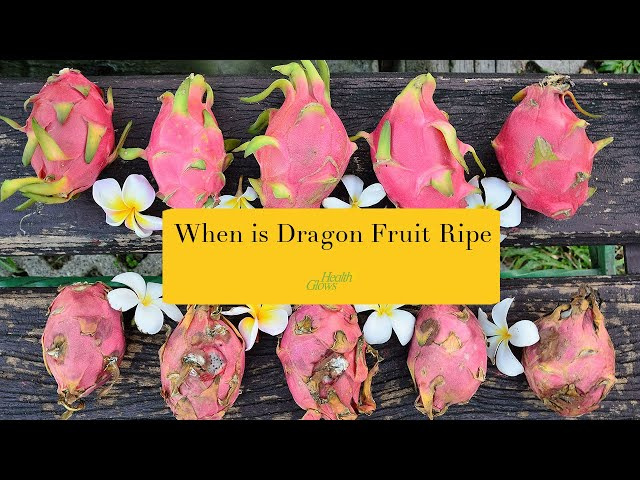Dragon fruit, with its vibrant colors and unique appearance, is not only a delight to the eyes but also offers an array of health benefits. Despite its exotic look, determining its ripeness can be a challenge, especially for those unfamiliar with this tropical fruit. A ripe dragon fruit can enhance your taste experience with its sweet and mildly tangy flavor. Picking a perfect one involves understanding its physical cues and subtle distinctions. With a little insight and guidance, you can become adept at selecting the ripest, most flavorful dragon fruits for your enjoyment.

Color and Texture Check
When considering whether a dragon fruit is ripe, the first thing to check is its color and texture—a ripe dragon fruit displays a bright and even coloration. Begin by examining the skin of the dragon fruit, which should be a vivid pink or red, although some varieties may have a yellow hue. A ripe fruit also develops slight give upon gentle pressure.
Detailed Steps:
- Look at the dragon fruit: A ripe one will have a vibrant, even color without many blotches.
- Feel the texture: Gently press the skin with your thumb. It should give a little, similar to a ripe avocado, indicating ripeness.
Summary:
Checking the color and texture is a quick way to discern ripeness. The benefits of this method are its simplicity and immediate feedback. However, overly soft skin can indicate overripeness or spoilage.
Leaf and Stem Examination
A telltale sign to check for ripeness in dragon fruit is its leaf-like bracts and stem. As the fruit matures, these parts change in appearance, which suggests that the dragon fruit is ready to be eaten.
Detailed Steps:
- Inspect the bracts: They should start to brown and dry out at the tips while remaining intact.
- Observe the stem: It should also begin to shrivel and dry, showing that the fruit’s growing process is complete.
Summary:
Leaf and stem examination provides a non-invasive way to judge ripeness. It preserves the fruit until it’s ready to be consumed but may require a keener eye to identify subtle changes compared to color and texture checks.
The Scent Test
A ripe dragon fruit emits a subtle but sweet aroma. To effectively perform a scent test, be in a neutral-smelling environment so your sense of smell is not overwhelmed by other odors.
Detailed Steps:
- Bring the dragon fruit close to your nose and take a gentle sniff.
- Identify if there’s a mild, sweet fragrance signaling ripeness. A lack of odor could indicate under-ripeness, while a sour or fermented smell could mean the fruit is overripe.
Summary:
The scent test is an excellent supplemental check to the visual and tactile methods. It’s beneficial as it enhances your sensory connection with the fruit selection process. However, the downside is that it can be subjective and may be less reliable for those not familiar with the fruit’s natural fragrance.
Field Spot Examination
A lesser-known indicator of a fruit’s journey from flower to maturity is the ‘field spot’. This is where the dragon fruit has been resting on the ground or against another surface as it grew.
Detailed Steps:
- Look for a yellow or lighter-colored spot on the fruit’s outer skin.
- Note the size and coloration: A ripe dragon fruit will have a well-defined field spot with even color transition.
Summary:
The field spot offers insight into the dragon fruit’s growth and ripeness state. It’s an indirect indicator and should be combined with other methods for accuracy. A clear downside is that not all dragon fruits will develop a discernible field spot, depending on how they are grown.
Weight Comparison
Ripe dragon fruits often have a satisfying heft to them due to their juicy content. Compare similar-sized fruits to identify which feels heavier, as this can hint at better ripeness.
Detailed Steps:
- Select two dragon fruits of comparable size.
- Gently weigh each one in your hands to determine which feels denser and heavier.
Summary:
Weight comparison is a simple method that provides additional reassurance in your selection. The heftier fruit is often the riper choice. However, this method isn’t foolproof since size differences can make assessment challenging.
Size Reckoning
Generally, a fuller-grown dragon fruit suggests better ripeness and flavor. It’s important not to confuse size with ripeness though, as some fruits are naturally smaller.
Detailed Steps:
- Evaluate the fruit’s size compared to others of the same variety.
- Select one that is comparatively larger, implying proper growth and potential ripeness.
Summary:
Size reckoning can be a straightforward way of identifying a potentially ripe dragon fruit. It assumes that larger fruits, relative to their typical variety size, have had more time to ripen. However, larger does not always guarantee better taste and ripeness.
Tapping Technique
A ripe dragon fruit has a certain resonance when tapped gently. This sound check can supplement your other senses in determining ripeness.
Detailed Steps:
- Lightly tap the dragon fruit’s skin with your fingers.
- Listen for a sound that’s somewhat hollow yet firm, indicating the right level of ripeness.
Summary:
The tapping technique engages an auditory clue to judging ripeness. While a fun trick, it’s not the most reliable method on its own and is best when confirming other indicators of ripeness.
Cut and Peek
If you have the opportunity, a quick peak inside the dragon fruit can give away its ripeness unequivocally. Do this when other assessments are inconclusive and you’re about to consume the fruit.
Detailed Steps:
- Make a shallow cut to expose a small section of the interior flesh.
- Check for vibrant coloration and absence of unripe, white splotches.
Summary:
The cut and peek is definitive, yet invasive, and should be a last resort. It’s ideal when the fruit will be consumed immediately. The downside is that once cut, the fruit’s shelf life is considerably reduced.
Seasonal Timing
Understanding the typical harvest times can increase your chances of encountering ripe dragon fruits. Seasonal timing doesn’t require examining the fruit itself but rather knowledge of its growing season.
Detailed Steps:
- Research the peak seasons for dragon fruit, which may vary by region.
- Shop for dragon fruits during these times for a higher likelihood of ripeness.
Summary:
Seasonal timing leverages agricultural patterns to guide your purchase. This method relies on larger trends and does not guarantee individual fruit ripeness. Its effectiveness also varies geographically.
Purchase Source
Finally, buying dragon fruits from reputable sources like farmer’s markets or specialty stores where turnover is high and fruits are well cared for can greatly affect ripeness quality.
Detailed Steps:
- Opt for purchasing from locations known for quality produce.
- Ask the vendor for details about the dragon fruit’s origin and ripeness signs they observe.
Summary:
The purchase source method reassures you that the fruits have been properly handled and likely selected for quality. However, even the best sources cannot guarantee you’ll always get a ripe fruit, and prices might be higher at specialty stores.
In conclusion, selecting a ripe dragon fruit doesn’t have to be a perplexing task. Whether you’re guided by visual hints, tactile feedback, or other sensory checks mentioned in our guide, you’re well-equipped to choose a deliciously ripe dragon fruit. Experiment with each method to find the one that works best for you, and enjoy the rewarding taste of success.
FAQs:
Q: How do I store a ripe dragon fruit?
A: A ripe dragon fruit should be stored in the refrigerator and consumed within a few days. If you want to prolong its freshness, wrap it in a paper towel and place it inside a plastic bag before refrigerating.
Q: Can I eat dragon fruit skin?
A: No, dragon fruit skin is not edible. Always remove the skin and consume only the flesh inside.
Q: How do I know if a dragon fruit is too ripe?
A: If a dragon fruit is mushy, has dark spots or blemishes, emits a sour scent, or the skin is excessively wrinkled, it might be too ripe or overripe.









